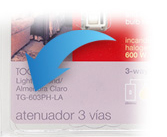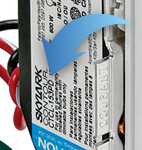
Explore Knowledge Articles
Troubleshooting QS Wired Shades
Wiring Troubleshooting with Link Diagnostics
Toolbox
When it comes to identifying potential wiring issues on a QS link, there are a few useful tools that we can use. Below is a list of tools ordered by accessibility:
- Controls - Controls (e.g. keypads) connected to the same QS link always come in handy to quickly identify the devices that are not controllable.
- Drive Blink Code - Inspecting the blink code on the drives can tell us whether a problem is caused by wiring issues or something else. For example, a shade not responding to controls can be caused by many problems, such as poor QS wiring, motor stalling, overheated, etc. Fortunately, unique blink codes are developed for different error conditions. By inspecting the blink code on the drive, we can possibly identify the root cause or at least filter out unrelated errors.
- Link Diagnostics - The Link Diagnostics feature provided by the shades and some power panels is a powerful tool in identifying and locating the wiring issues on the link.
Common Wiring Issues
- Disconnected Wires
- Disconnected MUX
- Disconnected MUX_BAR
- Disconnected both MUX and MUX_BAR
- Shorted Wires
- MUX and MUX_BAR shorted
- MUX and COM shorted
- MUX_BAR and COM shorted
- Flipped Wires
- MUX and MUX_BAR flipped
Notes: there could be multiple wiring issues on the same QS link.
Link Diagnostics
Link Diagnostics is a feature supported in QS shades and power panels that is used to debug QS wiring issues. Link Diagnostics Mode can be entered from any QS drives or power panels on the same QS link.
To enter Link Diagnostics Mode:
- Press and hold Close Limit button (solid black) for 5 seconds till the LED flashes green
- Tap CCW button
The device that Link Diagnostics Mode is entered from is called Link Diagnostics Master, and will exhibit the following behaviors:
- Wiggling (e.g. roller shades will be moving up and down)
- Flashing rapid green LED blink code - (8 per seconds)
Other devices on the same link will enter Link Diagnostics Slave Mode after receiving commands sent by the Link Diagnostics Master, they are called Link Diagnostics Slaves and will exhibit different behaviors depending on the actual QS wire connection to the master:
- If a Link Diagnostics Slave device always receives good commands, it will be:
- Wiggling
- Flashing slower green LED blink code - (1 per seconds)
- If a Link Diagnostics Slave device has received at least one corrupted command, it will be:
- Not moving
- Flashing rapid red LED blink code - (8 per seconds)
Devices on the same link will NOT enter Link Diagnostics Slave Mode if they have NOT received any good commands sent by the Link Diagnostics Master, there will be no response from these devices. This will also be an indication of wiring issues.
Wiring Troubleshooting pre-Link Diagnostics
How to check for Shade Wiring Problems
Below are some basic questions to get troubleshooting started:
- Are there any issues with the keypads? (wiring, communication, LEDs)
- What Is the power supply? (10 Ouput Power Panel, plug-in power supply, or junction box power supply)
- How many keypads & shades were used on the panel / transformer / junction box?
- Did they use Lutron wiring or supply their own?
- If they supplied their own, were the power supply & communication wires in the same shielding? (Communication wires should be shielded & twisted separately from the power wires)
- How soon did the issue start happening (as soon as it was installed / after a few weeks / few years.)
- Are there any LED blink codes or performance issues noticed prior to the call?
The first place to check is the Electronic Drive Unit (EDU) LED
Sometimes the drive is not easily accessible, either because of being tucked inside of a pocket, or having a coupled system with sheer and blackout shades. If this is the case, then just move on to the next section - checking the panel. If the EDU is easily accessible, then this is a good place to start.
- Try power-cycling the drive
- If there is no LED startup sequence, try tapping (at the same time) the open and closed limit buttons on the drive. If the LED starts blinking blue, update the Operating Software. If it doesn't start blinking blue, try powering the drive with a plug-in transformer.
- If it works with the transformer, then use the chart below to check the wire colors and the pin voltages at the drive, then move to the next section - check the panel.
- If it does not work with the transformer, then the problem is likely the drive, but it wouldn't hurt to try another outlet, just in case the customer did not use high-mag breakers and it tripped when this drive was powered up.
- If there is an LED startup sequence after power-cycling, see if the LED starts blinking blue quickly. This indicates either a wiring issue or communication issue. Try plugging in the drive with just a keypad and a plug-in transformer and see if it happens again. If it does, the problem is likely the drive. If it does not, plug it back in to the wire run and try the next step.
- Try all of the normal drive functions from the buttons. If the LED starts blinking red (stall mode) when trying to rotate, first check for snags and check to see if the edges of the shade material started fraying and got caught in the drive mandrel (the white plastic area where the buttons and LED are located).
- If there are no snags or frayed material, unplug the drive, wait for the blue LED to blink once, then plug it back in. If the LED starts blinking blue, ask for the IHA parameters. The tube diameter should be 1.67” (R64) or 2.56” (R100) and the fabric thickness should not be higher than absolute max of 41.9, but most fabrics are around 17-24/1000”. If the IHA parameters are set too high, then the voltage across the motor is reduced to the point that it is no longer able to rotate. Try setting the IHA parameters to default and see if this fixes the problem. If it does, suggest reducing or eliminating the custom IHA settings.
- Before moving away from the EDU and going to check the power supply, ask the customer to read off the wire colors at each pin in the connector. It should be (from pin 1-4) Black - Red - White - Purple. Write this down either in E1 as you're going through the TS process or use the chart below to refer to later. Also ask them to check the voltages at the drive between pins 1 & 2, 1 & 3 and 1 & 4. Also write this down on the chart below. Then go on to the next step - checking the panel.
The second place to check is the panel.
Check the pin voltages at the drive connector at the panel. If the drive wiring connected properly, then the approximate voltage readings should be as follows:
- Pin 1 to Pin 2: 36VDC (Black to Red) note: 24VDC for single power supply
- Pin 1 to Pin 3: 1.8VDC (Black to White)
- Pin 1 to Pin 4: 1.2VDC (Black to Purple)
- Note: the voltages from 1-3 and 1-4 may vary due to the opposing signals, but they should always add up to 3.0V - 3.3V
If the drive is not connected properly or if there is a break in the wire run, then Pin 1 to Pin 2 will read 0VDC at the drive, even though it may read 36V at the panel. Check the wire colors from pins 1-4 and compare those to the wire colors that you already wrote down from the drive connector. It's possible to mix up the wires at the connectors, which could cause power issues, and depending on which wires are mixed up, it could have an instantaneous or delayed effect. The drive will most likely still power up and may even move if the wires are incorrectly routed.
If the voltage readings are correct at the panel, check the pin voltages at the drive. The approximate voltage readings should be about the same as above. If the voltage readings at the drive do not match the panel readings, then try using the drive with a plug-in transformer and a keypad (as mentioned above). If the drive works fine in that setup, then there is a problem with the wire run.
Here is a useful table for confirming wiring. If the colors match, just put a check mark in the box, but it's best to write the actual value of the voltages at the drive and at the panel. Keep in mind that if the customer used their own cable supplier, then the colors may not match.
|
Wiring Check Chart | ||||||
|
Pin# |
Wire Color |
Color @ Drive |
Color @ Panel |
Volts to Pin 1 (approx.) |
Volts @ Drive |
Volts @ Panel |
|
1 |
Black |
|
|
N/A |
|
|
|
2 |
Red |
|
|
30 VDC |
|
|
|
3 |
White |
|
|
1.8 VDC |
|
|
|
4 |
Purple |
|
|
1.2 VDC |
|
|
Lutron QS Shade Wire Types
4 conductor
|
GRX-CBL-346S-500 |
(18AWG power wires) |
|
GRX-PCBL-346S-500 |
(Plenum, 18AWG power wires) |
|
QSH-CBL-M-500 |
(16AWG power wires) |
|
QSH-CBLP-M-500 |
(Plenum, 16AWG power wires) |
|
QSH-CBL-L-500 |
(12AWG power wires) |
|
QSH-CBLP-L-500 |
(Plenum, 12AWG power wires) |
2 Conductor (for Wireless)
|
QSHY-CBL-M-1000 |
(16AWG power wires) |
|
QSHY-CBLP-M-1000 |
(Plenum, 16AWG power wires) |


